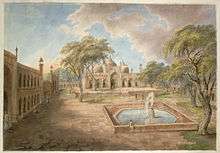Ghazi ud-Din Khan Feroze Jung I
Mir Shahâb ud-Din Siddiqi titled Farzand-i-Arjumand, Nawab Ghazi ud-din Khan Siddiqi Bayafandi Bahadur, Feroze Jung I, Sipah Salar (c. 1649–1710) was the son of Kilich Khan Khwaja Abid Khan Siddiqi Bayafandi the Sadr us Sudur of Mughal Emperor Aurangzeb and was raised to the rank of an Amir with the initial titles of Ghazi ud-Din Bahadur Khan and later Feroze Jung after his father's death. He was commander and chief at the Siege of Golkonda Fort in 1686 when Emperor Aurangzeb personally conquered Golkonda Sultanate taking the last Sultan Abul Hasan Qutb Shah prisoner.

Nobility
He was made Subahdar (governor) of Gujarat Subah (province) during the reign of the Mughal Emperor Bahadur Shah I. He died in Ahmedabad in 1710 and was taken to Delhi where he was buried in the yard of the college built by him in front of the Ajmeri Gate.[1] His son was the famous Qamar-ud-din Khan Siddiqi, Asaf Jah I the first Nizam of Hyderabad.
Men in his command included his son Qamar-ud-din Khan an others such as: Hamid Khan and Rahim-ud-din Khan.
Personal life
He was married first at Delhi with Wazirunisa Begum daughter of Nawab Saadullah Khan Bahadur wazir to Emperor Shahjahan. Having had issue a son and a daughter, Mir Qamaruddin Khan H.H. Asaf Jah I. Daughter married to Sahibzada Hamidullah Khan son of Imad Ul Mulk Nawab Khwaja Mohammed Mubariz Khan Bahadur sometime Subadar of Deccan.
Philanthropy

In 1690s, through religious endowment he founded a madarsa, Madrasa Ghaziuddin Khan after him. It became the historic and influential Delhi College which eventually paved way for the present Zakir Hussain College (University of Delhi), which in 1986, shifted to a new building outside Turkman Gate, the old structure in the Madrasa Ghaziuddin complex, still houses a hostel for the college and also has his Ghaziuddin's mausoleum.[2]
See also
References and sources
- References
- ↑ An oriental biographical dictionary: founded on materials collected by the late Thomas William Beale; by Thomas William Beale, Henry George Keene, 2nd edition, published by W. H. Allen, 1894, Original from the University of California
- ↑ Fanshawe, p. 64
- Sources
- H.C. Fanshawe (1998). Delhi, past and present. Asian Educational Services. ISBN 81-206-1318-X.